Genome-wide analysis of host mRNA translation during hepatitis C virus infection
- PMID: 23552407
- PMCID: PMC3676112
- DOI: 10.1128/JVI.00538-13
Genome-wide analysis of host mRNA translation during hepatitis C virus infection
Erratum in
-
Correction for Colman et al., Genome-Wide Analysis of Host mRNA Translation during Hepatitis C Virus Infection.J Virol. 2016 May 27;90(12):5846. doi: 10.1128/JVI.00507-16. Print 2016 Jun 15. J Virol. 2016. PMID: 27234346 Free PMC article. No abstract available.
Abstract
In the model of Huh-7.5.1 hepatocyte cells infected by the JFH1 hepatitis C virus (HCV) strain, transcriptomic and proteomic studies have revealed modulations of pathways governing mainly apoptosis and cell cycling. Differences between transcriptomic and proteomic studies pointed to regulations occurring at the posttranscriptional level, including the control of mRNA translation. In this study, we investigated at the genome-wide level the translational regulation occurring during HCV infection. Sucrose gradient ultracentrifugation followed by microarray analysis was used to identify translationally regulated mRNAs (mRNAs associated with ribosomes) from JFH1-infected and uninfected Huh-7.5.1 cells. Translationally regulated mRNAs were found to correspond to genes enriched in specific pathways, including vesicular transport and posttranscriptional regulation. Interestingly, the strongest translational regulation was found for mRNAs encoding proteins involved in pre-mRNA splicing, mRNA translation, and protein folding. Strikingly, these pathways were not previously identified, through transcriptomic studies, as being modulated following HCV infection. Importantly, the observed changes in host mRNA translation were directly due to HCV replication rather than to HCV entry, since they were not observed in JFH1-infected Huh-7.5.1 cells treated with a potent HCV NS3 protease inhibitor. Overall, this study highlights the need to consider, beyond transcriptomic or proteomic studies, the modulation of host mRNA translation as an important aspect of HCV infection.
Figures

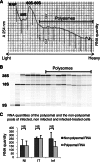
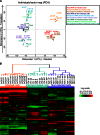


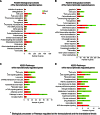
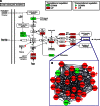
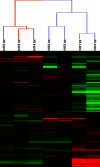
Similar articles
-
Cap and polyA tail enhance translation initiation at the hepatitis C virus internal ribosome entry site by a discontinuous scanning, or shunting, mechanism.J Hum Virol. 2001 Mar-Apr;4(2):74-84. J Hum Virol. 2001. PMID: 11437317
-
Unlike for cellular mRNAs and other viral internal ribosome entry sites (IRESs), the eIF3 subunit e is not required for the translational activity of the HCV IRES.J Biol Chem. 2020 Feb 14;295(7):1843-1856. doi: 10.1074/jbc.RA119.009502. Epub 2020 Jan 12. J Biol Chem. 2020. PMID: 31929110 Free PMC article.
-
Nonstructural 3 Protein of Hepatitis C Virus Modulates the Tribbles Homolog 3/Akt Signaling Pathway for Persistent Viral Infection.J Virol. 2016 Jul 27;90(16):7231-7247. doi: 10.1128/JVI.00326-16. Print 2016 Aug 15. J Virol. 2016. PMID: 27252525 Free PMC article.
-
Hepatitis C virus RNA translation.Curr Top Microbiol Immunol. 2013;369:143-66. doi: 10.1007/978-3-642-27340-7_6. Curr Top Microbiol Immunol. 2013. PMID: 23463200 Review.
-
Hepatitis C Virus Translation Regulation.Int J Mol Sci. 2020 Mar 27;21(7):2328. doi: 10.3390/ijms21072328. Int J Mol Sci. 2020. PMID: 32230899 Free PMC article. Review.
Cited by
-
Long noncoding RNA EGOT negatively affects the antiviral response and favors HCV replication.EMBO Rep. 2016 Jul;17(7):1013-28. doi: 10.15252/embr.201541763. Epub 2016 Jun 9. EMBO Rep. 2016. PMID: 27283940 Free PMC article.
-
Transcriptome Analysis Reveals Regulation of Gene Expression for Lipid Catabolism in Young Broilers by Butyrate Glycerides.PLoS One. 2016 Aug 10;11(8):e0160751. doi: 10.1371/journal.pone.0160751. eCollection 2016. PLoS One. 2016. PMID: 27508934 Free PMC article.
-
Assessment of mTOR-Dependent Translational Regulation of Interferon Stimulated Genes.PLoS One. 2015 Jul 24;10(7):e0133482. doi: 10.1371/journal.pone.0133482. eCollection 2015. PLoS One. 2015. PMID: 26207988 Free PMC article.
-
Generally applicable transcriptome-wide analysis of translation using anota2seq.Nucleic Acids Res. 2019 Jul 9;47(12):e70. doi: 10.1093/nar/gkz223. Nucleic Acids Res. 2019. PMID: 30926999 Free PMC article.
-
Fibrotic extracellular matrix activates a profibrotic positive feedback loop.J Clin Invest. 2014 Apr;124(4):1622-35. doi: 10.1172/JCI71386. Epub 2014 Mar 3. J Clin Invest. 2014. PMID: 24590289 Free PMC article.
References
-
- Aizaki H, Harada T, Otsuka M, Seki N, Matsuda M, Li YW, Kawakami H, Matsuura Y, Miyamura T, Suzuki T. 2002. Expression profiling of liver cell lines expressing entire or parts of hepatitis C virus open reading frame. Hepatology 36:1431–1438 - PubMed
-
- Ciccaglione AR, Marcantonio C, Tritarelli E, Tataseo P, Ferraris A, Bruni R, Dallapiccola B, Gerosolimo G, Costantino A, Rapicetta M. 2008. Microarray analysis identifies a common set of cellular genes modulated by different HCV replicon clones. BMC Genomics 9:309 doi:10.1186/1471-2164-9-309 - DOI - PMC - PubMed
-
- Pazienza V, Clement S, Pugnale P, Conzelmann S, Pascarella S, Mangia A, Negro F. 2009. Gene expression profile of Huh-7 cells expressing hepatitis C virus genotype 1b or 3a core proteins. Liver Int. 29:661–669 - PubMed
-
- Lindenbach BD, Evans MJ, Syder AJ, Wolk B, Tellinghuisen TL, Liu CC, Maruyama T, Hynes RO, Burton DR, McKeating JA, Rice CM. 2005. Complete replication of hepatitis C virus in cell culture. Science 309:623–626 - PubMed
Publication types
MeSH terms
Substances
LinkOut - more resources
Full Text Sources
Other Literature Sources
Molecular Biology Databases

